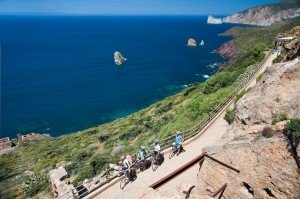After the first brainstorming about the concept, usually using a map to have an idea of stages and activities (see part 1), then we can start to actually design the tour.
Desk planning
This stage it’s an analysis of the area and possible routes at desk, using:
- Existing materials (guide books, web sites, tours of other tour operators…)
- Study of maps and orthophoto
- Planning possible itineraries and creating gps tracks
- Looking for possible services and vendors to be used on tour (hotels, restaurants, bike shops, guided visit and so on)
This process requires to keep in mind logistic and timing of each day, to avoid planning something that “doesn’t work”.
This job requires the use of a software (Compe gps, Garmin Base Camp…) or a website (Mapmyride, Bikemap, Googlemap…). In any case, having a paper map of the whole area, helps to get a quick view of the itinerary.
Lets say the truth…some operators “copy” existing tours from competitors. This is a fast way to develop a new destination, but the outcome is a tour that lacks of personality. Not to talk about the annoying feeling of being “trapped” on same hotels, restaurant, places…Even in the most popular destinations (Tuscany, Provence, Canary islands, Santiago, Loire valley, Passau Vienna and so on) a tour operator can give its own taste to a new tour.
Scouting and gps tracking
At this point we should have already an ideal program that potentially works. The planning at desk needs to be tested on the field, to actually check:
Roads: is there any new road, road works, landslides and so on?
Services to be used: are the hotels, restaurants, places we are supposed to stop, ok for our tour?
Logistic: is the timing well planned, allowing us to arrive in time for lunch/dinner/at hotel, and to do the planned activities. During the scouting we’ll create the “tools” we’ll use during the tour: gps tracks, road book, maps.
Gps tracks
We load on the gps the tracks we’ve created at desk, and we try to follow it, tracking again. The “real” tracks are more accurate than the ones realized by computer. Above all, there’s a real data about the climb (if the tool we are using is properly set), compared to the ones obtained by pc. Once we have the tracks, there’s a “postproduction” job in order to “clean” the tracks from errors (a new no entry sign, a new road, wrong turn during the scouting and so on). During the tracking we should have paper and pen to write notes about way points and info about the route. All this work should be done within 24 hours from tracking. If the Gps support it, we could load on the tracks the same info we use to create the road book, thus creating a customized navigation. Of course that is a simplification, the work of gps tracking would require a dedicated post.
Road book
The road book (or route notes), it’s a sheet that tells the cyclist the road to follow. It’s almost an “analogical” Gps, but still now it’s useful . Every tour operator has it’s own style, there are roughly three kinds:
- Icons > an intersection will be represented with an X, a traffic light with a simplified drawing and so on and so on. Sometimes they are too basic, so it takes a bit of practice to use it.
- Text > “At cross road with Church on right, TURN LEFT on via Roma”. They are accurate, but it’s not the safest way because it takes time to read a whole phrase while riding.
- Sketches or even pictures of way points > the easiest to use, but the most difficult to create, because it takes a different sketch for every point.
To create a road book you could start from the ones automatically generate (gogle map, for instance) then add to each point the inf you’ve got on the field.
Some suggestion to create a good road book:
Use clear landmarks: sometimes the road books are too simplified, but here and there a good “km 34.3 – You are in front of the loud pink building with yellow fluo shutters – turn RIGHT” is much better than using just a cold “Km 34.3 – turn RIGHT”.
Too much information is no information: e.g. “at the sunflower field turn LEFT”…what about if is not Sunflower season, or the farmer just changed plantation?
For dummies: e.g make it clear if the hotel is right or left , and write telefone number of hotel or place your guests are going to. It happned somebody checking on his gps, road book, map where exactely was the hotel. And he was standing under the entry sign.
Cartography
Depending on the tour we should supply our guests a proper map: the classic road map 1.250.000 may be ok for a road cycling tour, it’s not enough for a touring tour that uses back roads, it’s useless for a mtb tour. Let’s say a good map make a huge difference, should be created by a cartographer, and should have:
- Scale approximately 1:150.000 road, 1:100.000 touring , 1:50.000 biking
- Updated base map
- Profile
- Difference within road bikes, bike lanes, indicating roads with traffic, dirt section and so on
- Indicating touristic sites, hotels, bar and restaurants and water
- Integrated with sign posts, if existing

Sisteeeeeeer!!! Muoviti a portarmi la bici! *-*